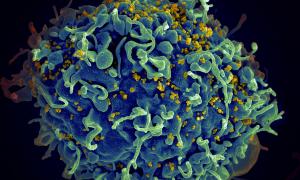IrsiCaixa and Vall d’Hebron map the HIV reservoir and describe the atlas of cells where the virus is hidden

This is the first time that all the cells that are part of the HIV reservoir in blood have been analysed at the same time, describing how and in which specific cell subtypes this reservoir is found in people receiving antiretroviral treatment
Antiviral treatments against HIV infection are not able to eliminate the virus from the body. The fact that HIV can go undetected in the DNA of the very cells it infects makes eradicating the virus a challenge for the scientific community. In order to achieve this, it is necessary to precisely describe the contribution of each of the cell types that provide shelter to HIV in the persistence of this virus within the organism, as has just been done by the Retrovirology and Clinical Studies group (GREC) of the IrsiCaixa AIDS Research Institute –a centre jointly promoted by the "la Caixa" Foundation and the Department of Health of the Generalitat de Catalunya–, together with the Translational Research group of the the Vall d'Hebron Research Institute (VHIR). For the first time, researchers have simultaneously studied whether HIV hides equally in the 13 cell subtypes analysed, as well as the contribution of these cells to the reservoir. "We have observed that each cell subtype contributes to the persistence of the reservoir through different mechanisms, such as susceptibility to infection, the amount of intact virus they hide, their half-life and proliferation capacity", explains Cristina Gálvez, first author of the study and postdoctoral researcher at IrsiCaixa. Knowing this atlas of the viral reservoir will allow the scientific community to design more precise and effective eradication strategies.
HIV can infect almost exclusively a specific type of immune system cell, called CD4 T-cells. It is within these same cells that the virus hides from the immune system, forming a viral reservoir that comes out of hiding when treatment is abandoned, making it impossible to eradicate the disease. "Within CD4 T cells, at least 13 different cell subtypes have been described that can act as a hiding place for the virus during antiretroviral treatment. In order to design precise strategies aimed at reducing the viral reservoir, we wanted to quantify which of these subtypes had the most hidden virus in order to address them as a priority", explains Javier Martínez-Picado, ICREA researcher at IrsiCaixa, who is surprised that "the results have been somewhat different from what we expected".
A heterogeneous mosaic of cells
Using peripheral blood samples from 14 patients of the Vall d’Hebron hospital and who have been living with HIV for more than 3 years and receiving antiretroviral treatment, researchers have been able to analyse the contribution of each cellular subtype to the viral reservoir and, therefore, to the persistence of the virus in the organism.
"Although we expected to find a marked pattern in the contribution to viral persistence, after this study we can confirm that HIV, under antiretroviral treatment, is present in all 13 cellular subtypes it infects, but heterogeneously", says Martínez-Picado."The results provide new information on the global composition of the HIV reservoir in blood in people receiving antiretroviral treatment," he adds. Each of these markers contributes in one way or another to the virus persisting in CD4 T cells or to the virus coming out of hiding under certain conditions. Moreover, until now it was not known whether all of these cells contained virus with infectious potential. "Most cells contain defective viruses that cannot replicate, but what we have seen in our study is that all 13 cell subtypes have HIV with the potential to infect new cells", explains Maria José Buzón, principal investigator at VHIR and one of the authors of the study. "This finding will help us to refocus possible clinical strategies for curing HIV infection", confirms Buzón.
The results of the study, published in the mBio journal of the American Society for Microbiology, show that the values of these parameters are different for each T-lymphocyte subtype and that, therefore, each one favours viral persistence by different mechanisms. However, they are all involved in the maintenance of the viral reservoir.
"One of the most striking cell subtypes after analysis are naive T cells, as they have very low values for all the parameters studied. However, we should not underestimate the contribution of this cell subtype in the viral reservoir, as other cells are derived from these cells, also from the reservoir, which have parameters with higher values", says Gálvez.
Combining strategies to eradicate HIV
As a result of the study, the IrsiCaixa and Vall d’Hebron teams have provided new scientific evidence regarding the HIV reservoir. The results obtained lead to the conclusion that, for virus eradication strategies to be effective, they cannot target specific cellular subtypes of the reservoir, but must be able to cover all T lymphocytes, each one with its own characteristics. "Having carried out for the first time the meticulous simultaneous study of each cellular subtype has allowed us to understand that it is necessary to find strategies that allow us to detect each of these cells that constitute the reservoir. One possible intervention would be to find treatments that make the reservoir visible, such as Latency Reversal Agents, so that the immune system or the combination of other treatments with these reversal agents can attack these virus-containing cells", concludes Martínez-Picado.